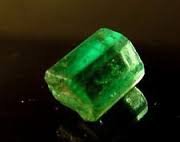Colombian mines, the source of the finest emeralds of the world, contain emerald-bearing veins in soft shale, making it easier to obtain larger sized uncut emerald stones. Read our guide for more facts and information…
Minerals, which are typically formed from cooling and solidification of molten rock and magma, also form beautiful crystals. Gemstones are the most prized crystals, and uncut gemstones have an ordinary appearance. Upon cutting and polishing, they acquire a characteristic brilliance as well as luster, rendering them valuable. Historically, gemstones are classified as precious and semi-precious stones. Emeralds, which come under the class of precious stones, are formed from a mineral called beryl, which is a chemical combination of beryllium, silicon, aluminum and oxygen. The color is imparted by additional trace elements like Chromium and Vanadium. Properties of different trace elements allow beryl to acquire different forms, such as aquamarine, a semi-precious stone.
Uncut emeralds from Muzo and Cosquez mines of Colombia
Though the Chivor mines of Colombia are historically known for Colombian emeralds, the mines at Muzo and Cosquez have the top quality emeralds. Unlike the Zambian emeralds that are recovered from schist rocks, the geology of the aforementioned Colombian mines contains emerald in calcite, quart, pyrites and dolomite, rubbing through carbonaceous limestone and shale. Therefore, blasting methods are not necessary to recover emeralds, which can be mined in a relatively easier manner, through the soft shale. Another advantage is the recovery of bigger and cleaner emerald stones.
Famous uncut Colombian emeralds
The Devonshire emerald is an uncut Colombian crystal of 1383.95 carats, in an eye-catching green color, recovered from the Muzo Mine, Colombia. It was gifted to the sixth Duke of Devonshire by Brazil’s Emperor Dom Pedro I in the year 1831.
The Patricia Emerald is permanently exhibited at the American Museum of Natural History, New York. It is a 632-carat uncut emerald of exceptional color, discovered in 1920 at Chivor, Colombia. At first, it was called ‘Patrizius’ in honor of St. Patrick of Ireland.
The Trapiche Emerald
The Trapiche Emerald, recovered in the Muzo Mine in 1879, has a unique spoke-like pattern, resembling a wheel. It is named after sugar cane crushing cogwheel that has spokes. This emerald is formed when carbon impurities penetrate the emerald crystal’s junction and form a radial pattern, giving the appearance of a six-pointed star. Known for its rarity, it is popular among collectors, and one such collection is Bogota’s Colombian Millennium Trapiche collection.
Large uncut emerald stones are rare and when compared to diamond, emerald is more expensive for the same weight. Raw and uncut Colombian emeralds have a hexagonal shape, and when looked at through a magnifying glass, small lines called inclusions are seen throughout the stone. Under the Chelsea filter, a true emerald stone glows in red or pink color due to the presence of Chromium.





